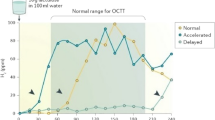Abstract
The aim of the study was to determine whetherthe specificity of the [14C]d-xylose breathtest could be improved, by excluding false-positivetests due to premature colonic metabolism of the[14C]d-xylose caused by rapid colonictransit. Forty-seven patients with suspected small bowelbacterial overgrowth were investigated by (1) aspirationand culture of duodenal fluid and (2) a[14C]d-xylose breath test. Those with either a positiveduodenal culture or breath test had a repeat[14C]d-xylose breath test given with one ofthree transit markers (barium, Gastrografin or99mTc-labeled tin colloid) to determine if the site of metabolism was inthe small bowel or colon. Fourteen patients had positiveduodenal cultures, four of whom had a negative[14C]d-xylose breath test, 15 patients had apositive [14C]d-xylose breath test, three ofwhich were due to colonic metabolism of the xylose.Where transit markers were used, 14C wasdetectable in the breath and serum before barium hadentered the small bowel, thus the barium did not comigrate withthe xylose. Gastrografin accelerated small boweltransit, leading to malabsorption of the xylose in thesmall intestine and subsequent colonic metabolism of the xylose. 99mTc-labeled tincolloid had no obvious disadvantages and appeared to bethe marker of choice. The use of a transit markerincreased the specificity of the[14C]d-xylose breath test from 85% to 94%. The specificity of the[14C]d-xylose breath test for the detectionof small bowel bacterial overgrowth is improved togreater than 90% by the use of an appropriate transitmarker.
Similar content being viewed by others
REFERENCES
Gorbach SL, Plaut AG, Nahas L, Weinstein L, Spanknebel G, Levitan R: Studies of intestinal microflora. Gastroenterology 53:856–867, 1967
Drasar BS, Shiner M, McLeod GM: Studies on the intestinal flora. Gastroenterology 56:71–79, 1969
Kirsch M: Bacterial overgrowth. Am J Gastroenterol 85:231–237, 1990
King CE, Toskes PP: Small intestinal bacterial overgrowth. Gastroenterology 76:1035–1055, 1979
Drude RB, Hines C: The pathophysiology of intestinal bacterial overgrowth syndromes. Arch Intern Med 140:1349–1352, 1980
Toskes PP: Bacterial overgrowth of the gastrointestinal tract. Adv Intern Med 38:387–407, 1993
MacMahon M, Lynch M, Mullins E, et al: Small intestinal bacterial overgrowth-An incidental finding? J Am Geriatr Soc 42:146–149, 1994
Tillman R, King C, Toskes P: Continued experience with the xylose breath test: evidence that the small bowel culture as the gold standard for bacterial overgrowth may be tarnished. Gastroenterology 80:1304, 1981
Riordan SM, McIver CJ, Bolin TD, Duncombe VM: Fasting breath hydrogen concentrations in gastric and small-intestinal bacterial overgrowth. Scand J Gastroenterol 30:252–257, 1995
Donald: The diagnosis of small bowel bacterial overgrowth in elderly patients. J Am Geriatr Soc 40:692–696, 1992
Haboubi NY, Mongowery RD: Small bowel overgrowth in elderly people, clinical significance and responce to treatment. Age Ageing 21:13–19, 1992
King CE, Toskes PP, Spivey JC, Lorenz E, Welkos S: Detection of small intestinal bacterial overgrowth by means of a 14C-d-xylose breath test. Gastroenterol 77:75–82, 1979
King CE, Toskes PP: Comparison of the 1-gram [14C]xylose, 10-gram lactulose-H2, and 80-gram glucose-H2 breath tests in patients with small intestine bacterial overgrowth. Gastroenterology 91:1447–1451, 1986
Fromm H, Hofmann AF: Breath test for altered bile-acid metabolism. Lancet 2:621–625, 1971
Wren MWD: Multiple selective media for the isolation of anaerobic bacteria from clinical specimens. J Clin Pathol 33:61–65, 1980
Young GO, O'Keefe SJD: Assessment of small bowel bacterial overgrowth by the 14C xylose breath test. S Afr J Clin Nutr 1:37–41, 1988
Fraser GM, Adam RD: Modifications to the gas-enhanced small bowel barium follow-through using gastrografin and compression. Clin Radiol 39:537–541, 1988
Rights and permissions
About this article
Cite this article
Lewis, S.J., Young, G., Mann, M. et al. Improvement in Specificity of [14C]d-Xylose Breath Test for Bacterial Overgrowth. Dig Dis Sci 42, 1587–1592 (1997). https://doi.org/10.1023/A:1018880524829
Issue Date:
DOI: https://doi.org/10.1023/A:1018880524829




